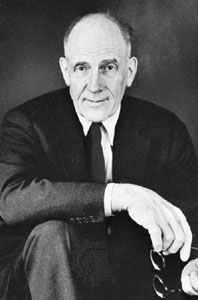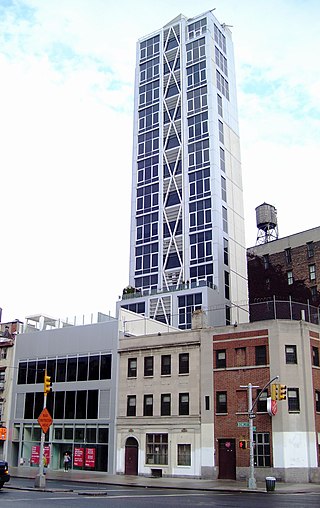
Wallace Kirkman Harrison was an American architect. Harrison started his professional career with the firm of Corbett, Harrison & MacMurray, participating in the construction of Rockefeller Center. He is best known for executing large public projects in New York City and upstate, many of them a result of his long and fruitful personal relationship with Nelson Rockefeller, for whom he served as an adviser.

Rockefeller Center is a complex of 19 commercial buildings covering 22 acres (89,000 m2) between 48th Street and 51st Street in the Midtown Manhattan neighborhood of New York City. The 14 original Art Deco buildings, commissioned by the Rockefeller family, span the area between Fifth Avenue and Sixth Avenue, split by a large sunken square and a private street called Rockefeller Plaza. Later additions include 75 Rockefeller Plaza across 51st Street at the north end of Rockefeller Plaza, and four International Style buildings on the west side of Sixth Avenue.

James Renwick Jr. was an American architect in the 19th century, noted especially for designing churches and museums. The Encyclopedia of American Architecture calls him "one of the most successful American architects of his time".

The Governor Nelson A. Rockefeller Empire State Plaza is a complex of several state government buildings in downtown Albany, New York.

1271 Avenue of the Americas (formerly known as the Time & Life Building) is a 48-story skyscraper on Sixth Avenue, between 50th and 51st Streets, in the Midtown Manhattan neighborhood of New York City. Designed by architect Wallace Harrison of Harrison, Abramovitz, and Harris, the building was developed between 1956 and 1960 as part of Rockefeller Center.

1251 Avenue of the Americas is a skyscraper on Sixth Avenue, between 49th and 50th Streets, in the Midtown Manhattan neighborhood of New York City. It is owned by Mitsui Fudosan. The structure is built in the international style and looks like a simple cuboid devoid of any ornamentation. The facade consists of alternating narrow, vertical stripes of glass and limestone. The glass stripes are created by windows and opaque spandrels, forming continuous areas that are washed by machines sliding down the facade. A seven-floor base wraps around the western portion of the building, and there is a sunken plaza with a large two-tier pool and fountains facing Sixth Avenue. In the plaza stands the bronze statue named Out to Lunch by John Seward Johnson II—of the same series as the one standing outside 270 Park Avenue.

Eggers & Higgins was a New York architectural firm partnered by Otto Reinhold Eggers and Daniel Paul Higgins. The architects were responsible for the construction phase of the Jefferson Memorial beginning in 1939, two years after the death of its original architect, John Russell Pope, despite protests that their appointment had been undemocratic and therefore "un-Jeffersonian". Critics argued a competition should have been held to choose Pope's successor. In 1941, they also completed construction of Pope's other famous design, the West Building of the National Gallery of Art, also in Washington, D.C.

Robert Michael Scarano Jr. is an American architect who works primarily in Brooklyn, New York City. In March 2010, Scarano was barred from submitting plans for new buildings to New York City's Department of Buildings.

Starrett & van Vleck was an American architectural firm based in New York City which specialized in the design of department stores, primarily in the early 20th century. It was active from 1908 until at least the late 1950s.

Elliott Lynch, AIA, was an American architect active in the late 19th and early 20th centuries in New York City. His office was located at 347 Fifth Avenue in Manhattan. Many of the buildings he designed remain standing.

Jacques André Fouilhoux was a French-born architect active in the United States from 1904 to 1945. He is most well known for his work on Tribune Tower in Chicago; Rockefeller Center; early skyscrapers such as the Daily News Building and 30 Rockefeller Plaza; and the 1939 World's Fair in New York, for which he designed the central Trylon and Perisphere. Many of his early works are also listed in the National Historic Register, including 705 Davis Street Apartments and Wickersham Apartments in Portland, Oregon. According to the New York City Landmarks Preservation Commission, Fouilhoux has received less attention than partners such as John Mead Howells and Raymond Hood, but was "known as an astute engineer and a painstaking supervisor and his work gained the respect of his collaborators."

Raymond F. Almirall (1869–1939) was an American architect of the Beaux-Arts period, practicing in New York City.

Hoffmann Architects, Inc., d/b/a Hoffmann Architects + Engineers, is a private architecture and engineering firm based in New Haven, Connecticut, United States, with offices in New York City and Alexandria, Virginia. Founded in 1977 by Hungarian-born architect John J. Hoffmann, the firm specializes in the rehabilitation of the building envelope, including facades, roofs, plazas, terraces, and parking structures, as well as historic / landmark building restoration.
Buttrick White & Burtis Architects was an architecture firm based in New York City, established in 1981 by the architects Harold Buttrick, Samuel G. White, and Theodore A. Burtis III. The firm remained active until 2002. Harold Buttrick left in 1998 to form Murphy Burnham & Buttrick. The architect Jean P. Phifer was a partner of the firm from 1989 until 1996, after which she served as president of the New York City Public Design Commission from 1998 to 2003. The architect Michael Dwyer was associated with the firm from 1981 to 1996. The architect and educator William W. Braham was associated with the firm from 1983 to 1989. In 2002, Buttrick White & Burtis merged with Platt Byard Dovell to become Platt Byard Dovell White.

Max O. Urbahn (1912–1995) was a German-born American architect in practice in New York City and Connecticut from 1945 until his death in 1995. Among his notable projects is the Vehicle Assembly Building at the Kennedy Space Center, one of the largest buildings in the world. He served as president of the American Institute of Architects for the year 1972.
Kliment Halsband Architects (KHA) was founded in New York City in 1972 by Robert Kliment and Frances Halsband. The New York City based firm is known for their architecture, master planning, interior design, adaptive reuse, historic preservation and transformation of institutional buildings. KHA's work expertise includes cultural, educational, governmental, and most recently healthcare buildings. In 2022, Kliment Halsband Architects joined forces with Perkins Eastman to become "Kliment Halsband Architects—A Perkins Eastman Studio."

Robert C. Broshar was an American architect in practice in Waterloo, Iowa from 1956 to 1996. He spent nearly his entire career with the firm now (2023) known as INVISION Architecture and was president of the American Institute of Architects for the year 1983.

Sherwood, Mills & Smith, known after 1968 as the SMS Partnership and as SMS Architects, was an American architecture firm active in Stamford and New Canaan, Connecticut from 1946 to 2000. Initially the partnership of architects Thorne Sherwood, Willis N. Mills and Lester W. Smith, the firm grew into one of the most influential in the region.

Arthur R. Mann was an English-born American architect and engineer in practice in Hutchinson, Kansas from 1909 until his retirement in 1965. In 1924 he formed the firm of Mann & Company, which remained under family ownership until 1977 and is still in business.

Keyes, Lethbridge & Condon was an American architectural firm active, under several different names, in Washington, D.C. from 1951 to 1997. It was founded in 1951 as Keyes, Smith, Satterlee & Lethbridge before splitting into Keyes & Lethbridge and Satterlee & Smith in 1956. Keyes & Lethbridge became Keyes, Lethbridge & Condon in 1958 and Keyes Condon Florance in 1975. After two more name changes it reverted to Keyes Condon Florance in 1995 and was merged into SmithGroup in 1997.






















